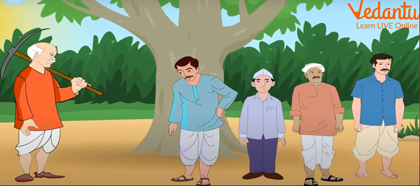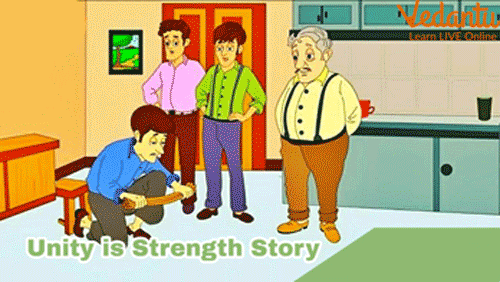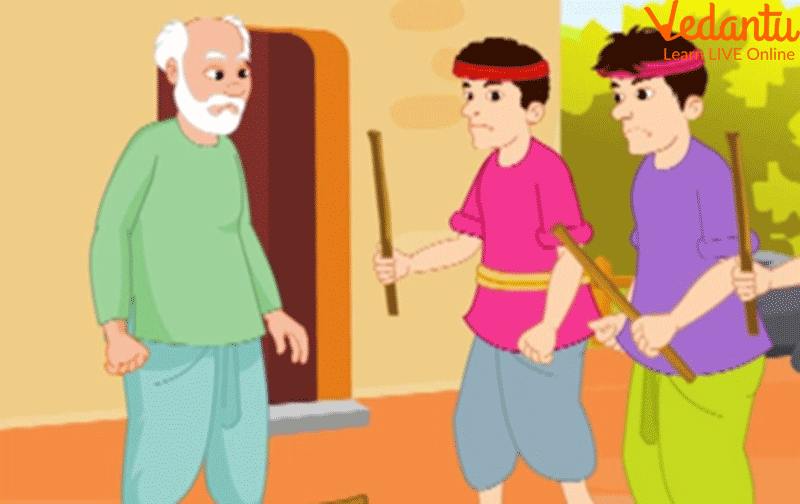Story of the Farmer and His Sons

Introduction to the Farmer and His Sons Story
Children are taught lessons or values through Aesop's fables. Each fable has brought to life significant concepts that have stood the test of time, such as the maxim "honesty is the best policy" or the adage "slow and steady wins the race".

Farmer and his Sons Story
The fables can also make it easier for us to see human vices and flaws that might not be as obvious otherwise. Kids learn more about their immediate environment and the people, actions, and circumstances they may face through the fables.
The Story

Farmer and His Sons
Here is the farmer and his son's story for kids.
Once, an elderly farmer lived in a village. He had four sons. They always argued with one another. The farmer made numerous attempts to bring them together, but they were unwilling to pay heed to his counsel. He was extremely concerned for their future.
The elderly farmer decided to bring his sons together after he fell ill one day. He asked his sons to bring a few sticks to him. They brought the sticks. The farmer asked his oldest son to bundle them together. Then he challenged them to use all of their might to smash it.

The Sons are Praying for their ill Father
Each son attempted to break the bundle but was unsuccessful. The farmer then untied the bundle, gave the sticks to each of them, and instructed them to break them. They were all able to do it with ease.
"Now you get it?" the farmer asked. “If you stand together, no one can defeat you. But as long as you fight, anyone can break you,” he explained.
Characteristics of a Fable

The Farmer is Watching his Sons
Most of us quickly recall Aesop’s fables and perhaps a well-known tale like ‘The Tortoise and The Hare’ when someone mentions the word "fable". Fables are a particular category of folktales that have been passed down orally through many generations of re-telling. Generally speaking, a fable can be distinguished by three elements:
Animals or inanimate objects that act like people are called characters.
The moral lesson is illustrated through the story, usually done at the conclusion.
The story is short, typically lasting no more than two to three pages.
Benefits of Reading Fables

The Angry Farmer is Looking at his Sons
Children's perspectives on the world are widened when they become aware of diverse cultural traditions. Fables frequently inspire children to discover more about their own cultural traditions or to develop a curiosity about the world.
As you can see, fables have several advantages for youngsters and may be used in various ways to aid young readers. They not only serve to impart moral teachings but help youngsters in a variety of ways, such as-
Discover other cultures
Model personality qualities.
Respect diverse cultural practices.
Examine many perspectives on the world.
Develop a passion for stories.
The Moral of the Story

Moral of Farmer and his Sons Story
The moral of the Farmer and His Sons Story is that we should live in harmony like a bundle of sticks. It will be easy to break us if we fight among ourselves.
Summary
A fable's main goal is to teach its audience a moral lesson. These stories are especially interesting to young children.
We learn from the story that the bundle of sticks was held together and that no matter how hard one attempted to break, they were always united. This demonstrates the power of cooperation. The farmer, therefore, intended to teach them that nobody could harm his four sons when they were together.


FAQs on Story of the Farmer and His Sons
1. What lesson can we learn from the tale of the farmer and his sons? What did the farmer do?
Nobody can separate you if you stick together. You must coexist in order to prevent harm to you. As we know that his sons’ always used to fight with each other. The farmer was fed up with them and gave them a task in order to teach them a lesson. At the end of the story, it is seen that his sons’ lived peacefully, which pleased the farmer. The moral is we are stronger together and weaker apart.
The farmer asked his oldest son to bundle the sticks together. Then he challenged them to use all of their might to smash it. Each son attempted to break the bundle but was unsuccessful. The farmer then untied the bundle and asked them to break the sticks.
2. What makes a tale good? What makes fables so significant?
The best stories are well-told and focus on a topic that the reader feels is relevant. The best stories are more comprehensive. They have more material that has been independently verified and comes from more experts and perspectives. They demonstrate greater initiative and reporting effort.
The value of fables: Fables are enduring literary devices because they can convey moral lessons in a manner that is easy for readers of all ages to understand and enjoy. Fables are among the oldest and most enduring types of verbal and written storytelling.
3. Name five popular stories for kids that teach children honesty and cleverness.
The following are the five popular stories for kids that teach children honesty and cleverness.
The Boy Who Cried “Wolf!”
The Honest Woodcutter.
The Lazy Donkey.
Farmer’s Well and Witty Birbal.
The Bear and The Two Friends.




